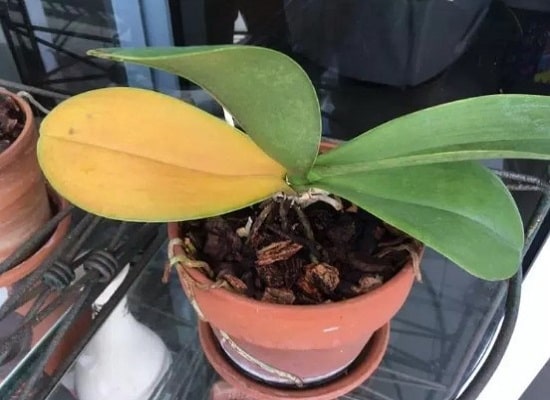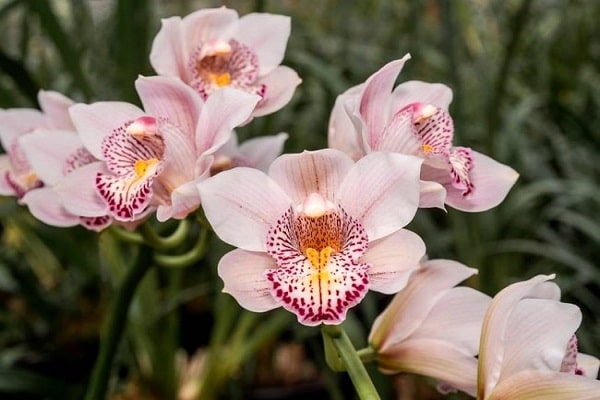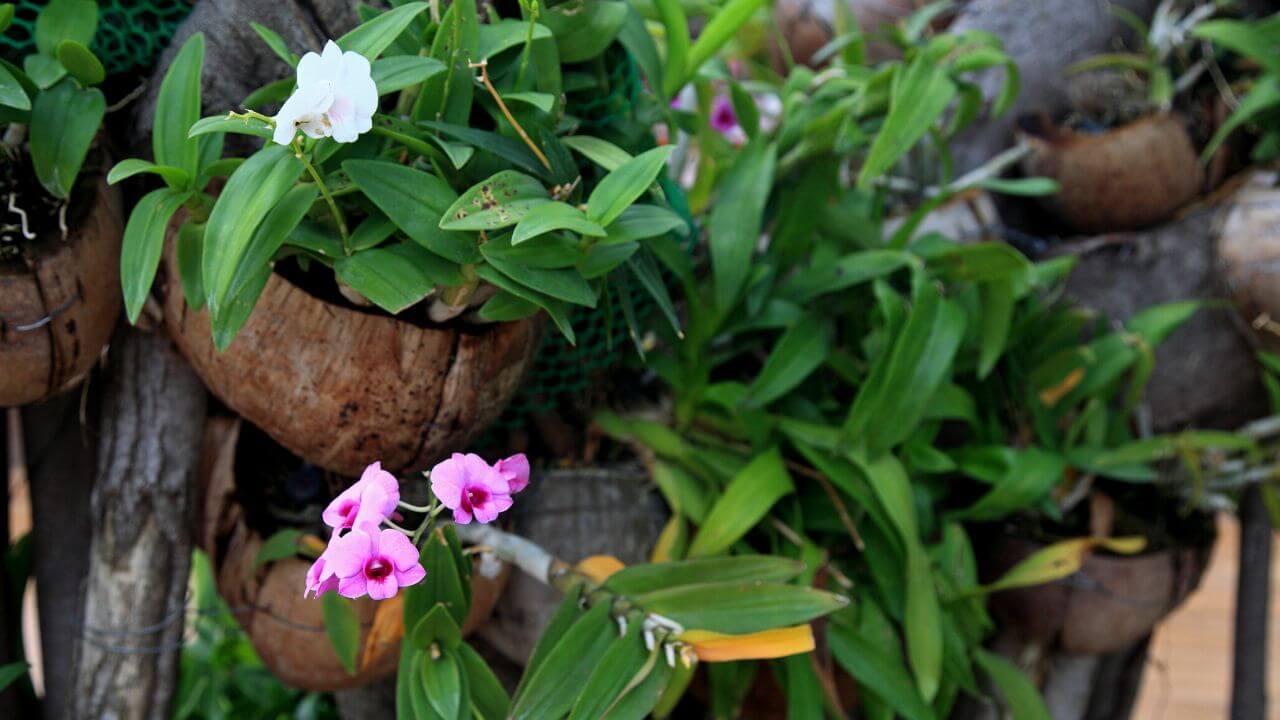Cymbidium orchids are valued for their long-lasting, colorful flowers that come in white, yellow, pink, and purple, among other colors. But sometimes, why is my cymbidium orchid not flowering, leaving their owners to wonder what went wrong.
Your cymbidium orchid is not flowering because of insufficient light, the wrong temperature, the wrong amount of water, or improper nutrients.
In this article, I’ll discuss these possible reasons and give tips on getting your cymbidium orchid to bloom again. Read on to find out more.
Quick Navigation
7 Potential Causes And Solutions: Why Is Your Cymbidium Orchid Not Flowering?

The inability of your cymbidium orchid to bloom might be attributable to several factors. Listed below are seven potential reasons and their corresponding remedies:
Insufficient Light
Insufficient light can cause a cymbidium orchid not to flower. Cymbidium orchids require bright, indirect light to thrive and produce flowers. If your orchid needs more light, it may need help to make flowers or have them.
If your cymbidium orchid is not blooming due to inadequate light, consider these solutions:
- Move Your Orchid To A Location With More Light: Cymbidium orchids need robust and indirect light. Try relocating your orchid to a south-facing window.
- Use Artificial Lighting: Use artificial illumination if your orchid doesn’t get enough natural light. Grow lights or fluorescent lights may illuminate your orchid.
- Increase Light Exposure: Orchids require sunlight to bloom. Increase morning sunshine for your orchid.
- Rotate Your Orchid: Orchids incline toward the light, making them unequal. Rotate your orchid to provide equal light.
Nutrient Deficiencies
If a cymbidium orchid doesn’t get enough food, it might not bloom. Orchids need a well-balanced diet so that they can grow and bloom. If your orchid needs to get more of the proper nutrients, it might not bloom as well or might even stop.
Let’s say that your cymbidium orchid isn’t blooming because it isn’t getting enough nutrients. If that’s the case, you can try a few things to fix the problem:
- Fertilize Your Orchid: Orchids require balanced nutrition to grow and bloom. If your orchid lacks nourishment, it may not blossom. Balanced orchid fertilizer will remedy this.
- Choose The Right Potting Mix: Orchids require an excellent potting mix to grow and bloom. The poor potting mix may deprive your orchid of nutrition. Repot your orchid in a good orchid mix.
- Check The pH of The Potting Mix: Orchids like potting soil with a pH of 6.0–6.5. Your orchid may not obtain enough nutrients if your potting mix pH is too high or low. Check your potting mix pH and apply pH-adjusting solutions to correct this.
- Check The Root Health: Healthy roots help orchids absorb nutrition and grow. Your orchid may not absorb food if its roots are injured or sick. Check your orchid’s roots periodically and rectify any issues.
Incorrect Temperature
If the temperature is wrong, a cymbidium orchid might not bloom—Cymbidium orchids like cooler temperatures, especially at night. If the temperature around your orchid is too high, it may struggle to make flowers or may not make any flowers at all.
Your cymbidium orchid may not blossom owing to improper temperature. If so, try these solutions:
- Provide Your Orchid With An Acceptable Temperature Range: Cymbidium orchids need lower conditions, particularly at night. Keep your orchid between 50-60°F (10-15°C) at night and 60-70°F (15-21°C) during the day.
- Use A Thermometer To Monitor The Temperature: To keep your plant at the appropriate temperature, use a thermometer.
- Use A Cooling Pad Or Fan: If the temperature in your home is too high for your orchid, you can use a cooling pad or fan to lower the temperature around the plant.
- Avoid Placing Your Orchid Near Heat Sources:Keep your orchid away from heat sources such as radiators, heat vents, and fireplaces.
Overwatering Or Underwatering

Overwatering or underwatering can cause a cymbidium orchid not to flower. Orchids are sensitive to the amount of water they receive and need a well-draining potting mix to thrive. Orchids are exposed to water conditions and may not bloom or produce only a few blossoms if they are over- or under-watered.
Suppose your cymbidium orchid is not flowering due to overwatering or underwatering. In that case, there are a few things you can try to fix the problem:
- Check The Soil Moisture Regularly: Orchids are sensitive to how much water they get, so you should check the soil often. To keep your orchid from getting too much or too little water, check the soil moisture and water when the top inch of the soil is dry.
- Use The Right Potting Mix: Orchids need a well-draining potting mix to thrive. If you use a potting mix that retains too much water, your orchid is at risk of overwatering. To fix this, repot your orchid in a well-draining potting mix.
- Use The Right Pot: Use a container with drainage holes to avoid overwatering orchids. Orchids in pots without drainage holes may overwater. Repot your orchid in a drainage-holed container.
- Check For Root Rot: Root rot may harm orchids if overwatered. Gently remove the orchid from its container and examine the roots for root rot. Brown, mushy roots indicate orchid rot. Repot your orchid in a well-draining mix and waterless.
Cymbidium Orchid Not Flowering For Age

Cymbidium orchids might stop blooming as they get older. Cymbidium orchids bloom for many weeks every year. There may be a better time of year for your orchid to bloom. In this scenario, you can only wait for the blooming season and care for your orchid.
If your orchid is an older plant that has not flowered in a long time, there are a few things you can try to encourage it to flower:
- Provide The Proper Care: Orchids require adequate care to grow and bloom. Give your orchid enough light, water, and nutrients. Avoid severe heat.
- Repot The Orchid: If it is pot-bound or the potting mix is old, it may not blossom. Repot your orchid in a new potting mix.
- Prune The Orchid: Pruning the orchid means taking off old, dying, or damaged flowers and leaves. This can help your orchid grow and bloom again. To keep the plant from getting hurt, use clean and sharp scissors.
Insects & Pests
Yes, insects and pests can cause a cymbidium orchid not to flower. Orchids are prone to various problems, including aphids, mites, thrips, and mealybugs, damaging the plant and preventing it from flowering.
To fix this problem, you can try the following:
- Inspect Your Orchid Regularly: Check your orchid regularly for signs of pests, such as small, sticky honeydew deposits or white, cottony masses.
- Use Appropriate Pest Control Methods: If you notice problems on your orchid, use appropriate pest control methods to get rid of them. This may include using insecticides, releasing beneficial insects such as ladybugs or lacewings, or using physical processes such as handpicking or hosing off the pests.
- Keep The Area Around Your Orchid Clean: Pests are attracted to dirty, cluttered environments. Keep the site around your orchid clean and clutter-free to help prevent pests from taking up residence on your plant.
Diseases Can Cause Cymbidium Orchid Not Flowering
Diseases can cause a cymbidium orchid not to flower. Orchids are prone to various conditions, including bacterial and fungal infections, damaging the plant and preventing it from flowering.
To fix this problem, you can try the following:
- Inspect Your Orchid Regularly: Check your orchid regularly for signs of diseases, such as discolored or wilted leaves, black or brown spots on the foliage, or mushy or rotten roots.
- Provide The Right Care: Proper care is essential for preventing diseases in orchids. Ensure you provide your orchid with the right amount of light, water, and nutrients. Avoid placing it in areas with extreme temperatures.
- Use Appropriate Disease Control Methods: If you notice signs of a disease on your orchid, use appropriate disease control methods to treat it. This may include using fungicides or bactericides, removing infected parts of the plant, or using physical processes such as copper tape or sulfur.
Most Commonly Asked Questions
How Many Times Does An Orchid Plant Flower Per Year?
Depending on species and circumstances, orchids may blossom many times a year. Some orchids bloom year-round. Others may only bloom twice a year. Light, temperature, humidity, and fertilizer affect flowering frequency. Orchids need care to develop and blossom. To encourage flowering, give the plants enough sunshine, water, and balanced fertilizer.
How Long Do Cymbidium Orchid Blooms Last?
The length of time that a Cymbidium orchid bloom depends on the type of orchid and the conditions in which it grows. Generally, the Cymbidium orchid flowers can last from a few weeks to a few months.
Some Cymbidium orchids have flowers that last a few weeks, while others have flowers that last a few months. The flowers can also last longer if the orchid gets enough light, is kept at the right temperature and humidity, and is cared for.
How To Get Cymbidium Orchids To Flower Again?
You can help your Cymbidium orchids bloom again by taking the following steps:
To help encourage your Cymbidium orchid to flower again, there are a few things you can try:
- Provide The Orchid With Proper Care: Ensure it gets enough light, water, and fertilization to help it thrive.
- Repot The Orchid If Necessary: If the orchid is pot-bound or the potting mix is old and depleted, consider repotting the orchid in a fresh potting mix.
- Check The Temperature And Humidity Levels: Cymbidium orchids like 60-70°F and 50-70% humidity. Use a humidifier or place the orchid on a tray of water-filled stones to improve humidity.
- Prune The Orchid If Needed: Remove any dead or damaged foliage and flowers to help the orchid focus its energy on producing new flowers.
- Provide The Orchid With A Winter Rest Period: Cymbidium orchids typically go through a dormant period during the winter months, during which they do not actively grow or produce flowers. During this time, reduce watering and fertilization and provide the orchid cooler temperatures.
What Is The Best Position For Cymbidium Orchids?
Cymbidium orchids prefer bright, indirect light, with a location that receives morning sun and afternoon shade being ideal. They generally do best in an area that receives dappled shade throughout the day. Avoid placing the plants in direct sun, as this can scorch the leaves and prevent the plant from flowering.
What Fertilizer For Orchids To Bloom?
Orchids need 20-20-20 NPK fertilizer. The fertilizer has equal nitrogen, phosphorus, and potassium. Orchids need these three nutrients to thrive.
Over-fertilizing orchids may cause leaf burn and stunted development, so observe the fertilizer label. To avoid overfeeding the orchid, dilute the fertilizer to half-strength.
Final Word
Cymbidium orchids need certain conditions to bloom. The plant needs the right amount of light, water, nutrients, and temperature to grow well and make flowers.
If your cymbidium orchid doesn’t bloom, it could mean that something needs to be balanced. Pay attention to how your plant’s leaves and soil are doing, and make changes as needed so you can enjoy its beautiful flowers.

My name is Md Deloar Hossain and I’m the creator of Club Gardening, designed for all your gardening ideas, gardening product reviews, and a place to help you find the best gardening experience possible.


